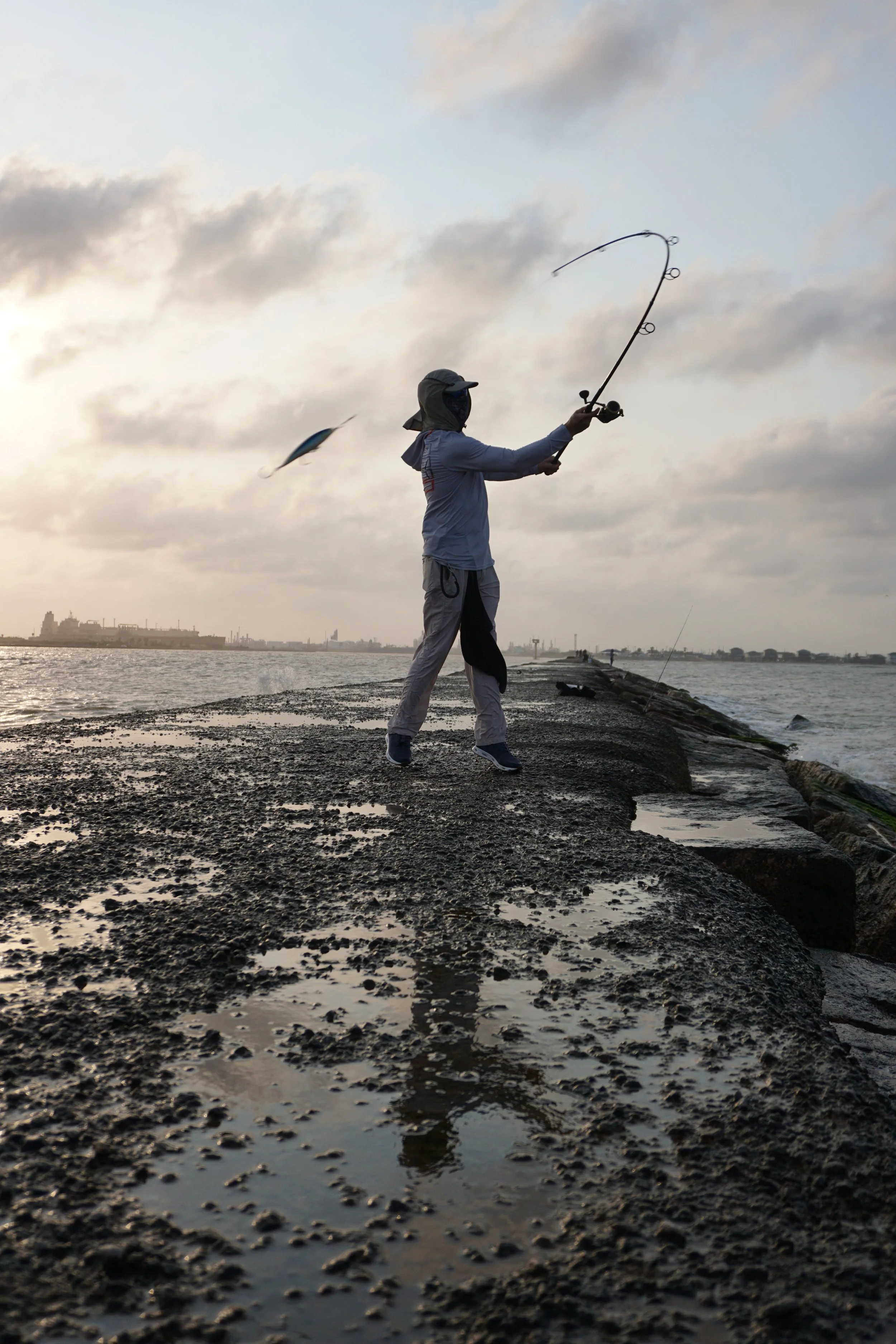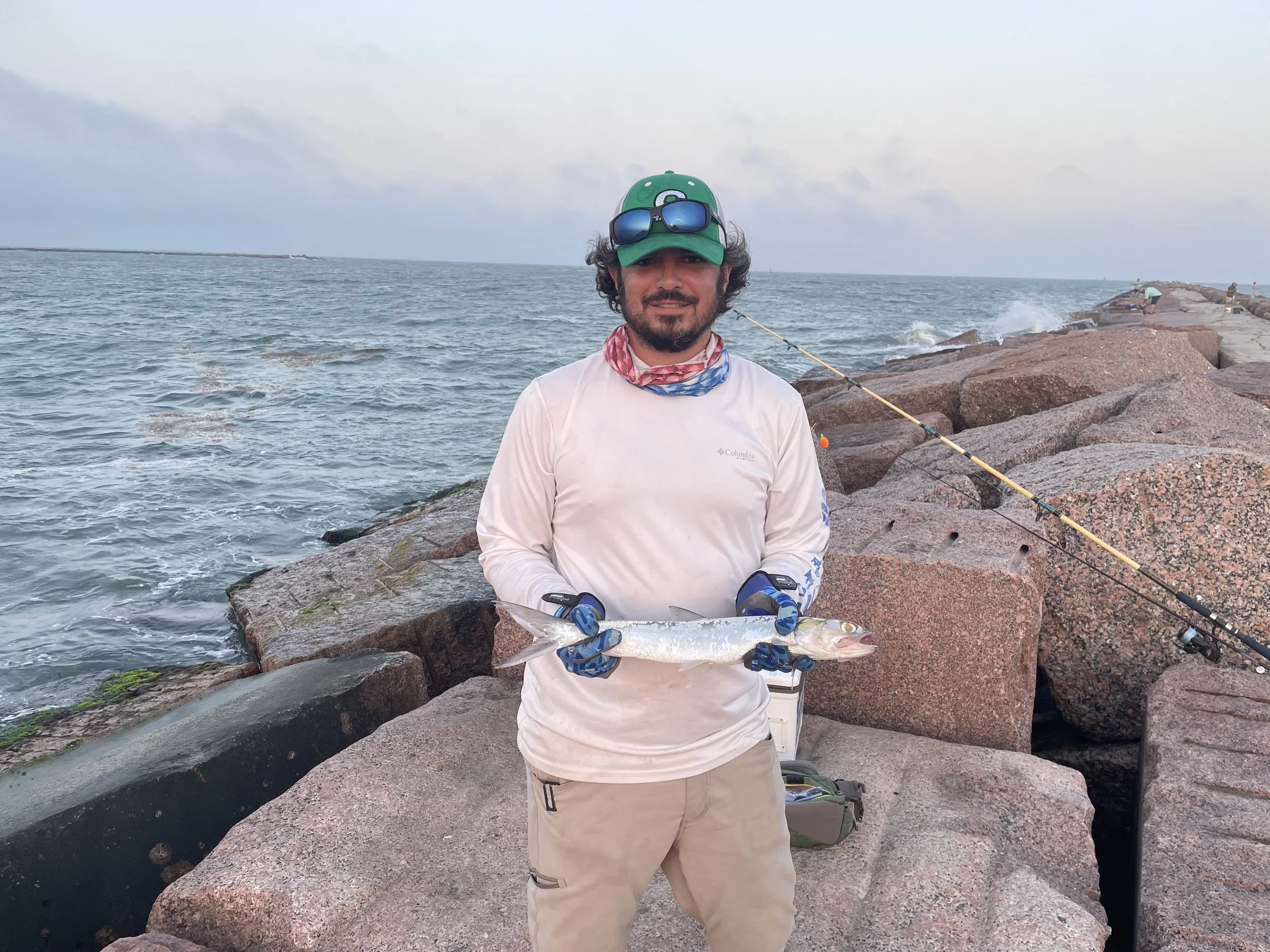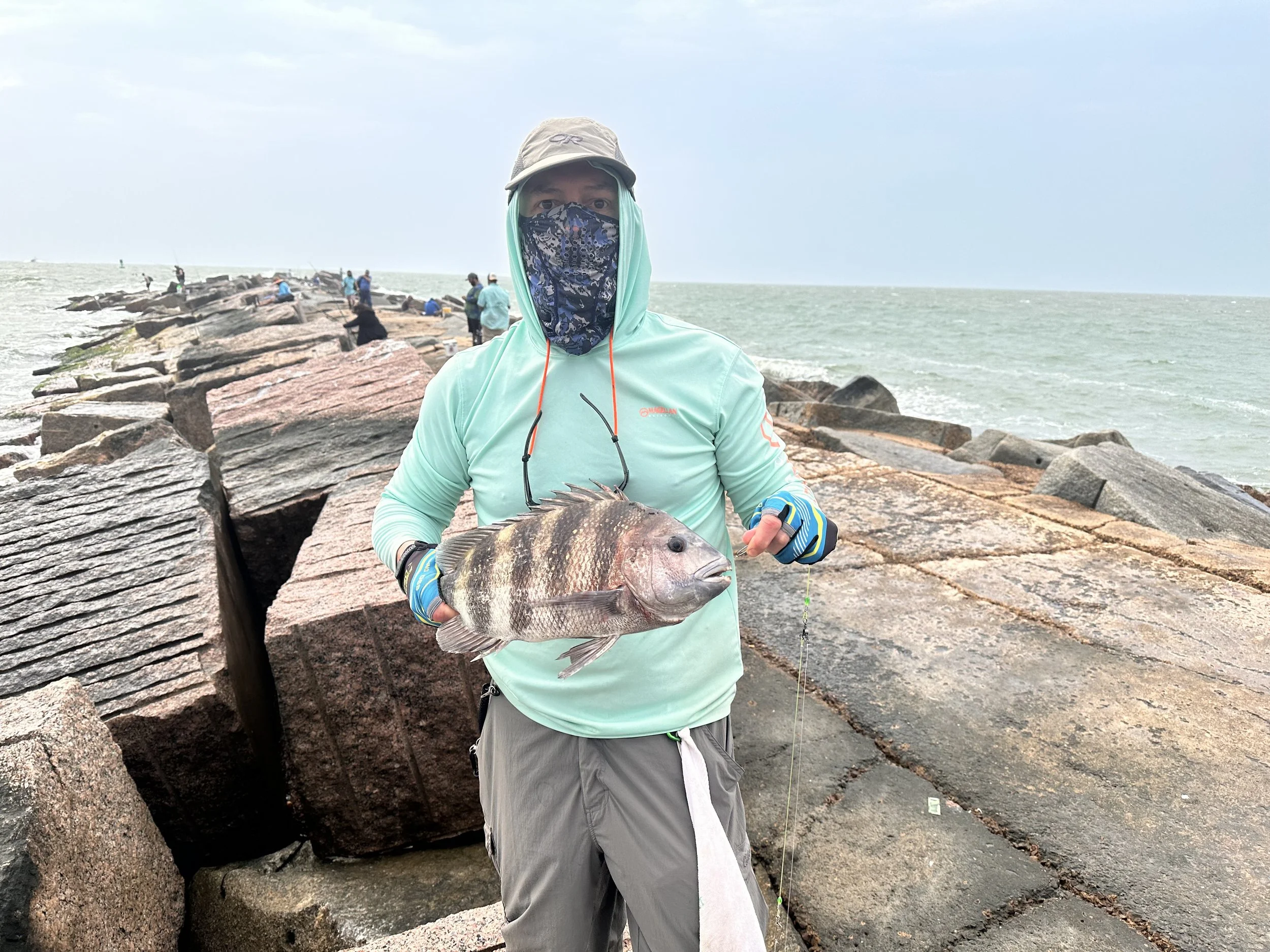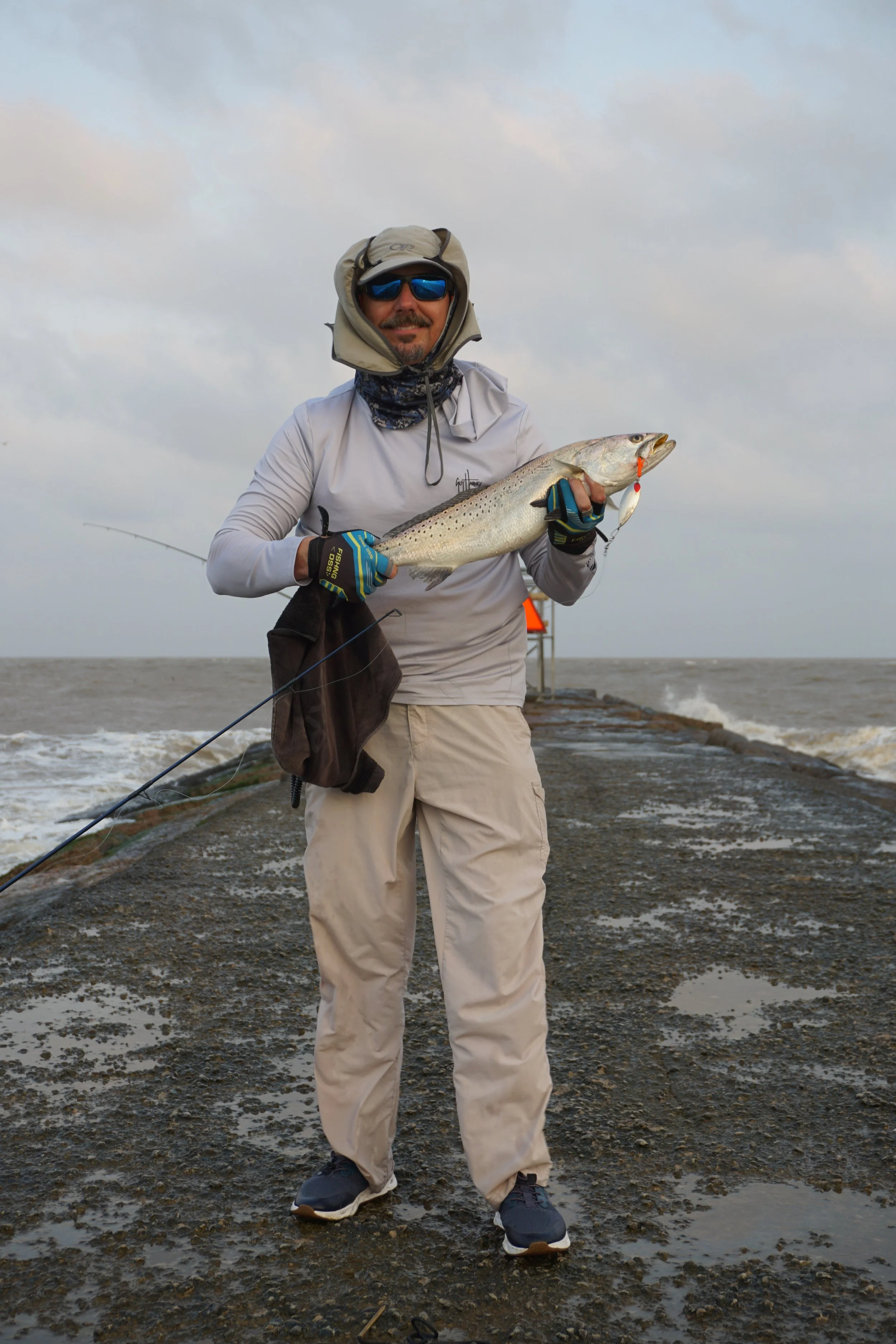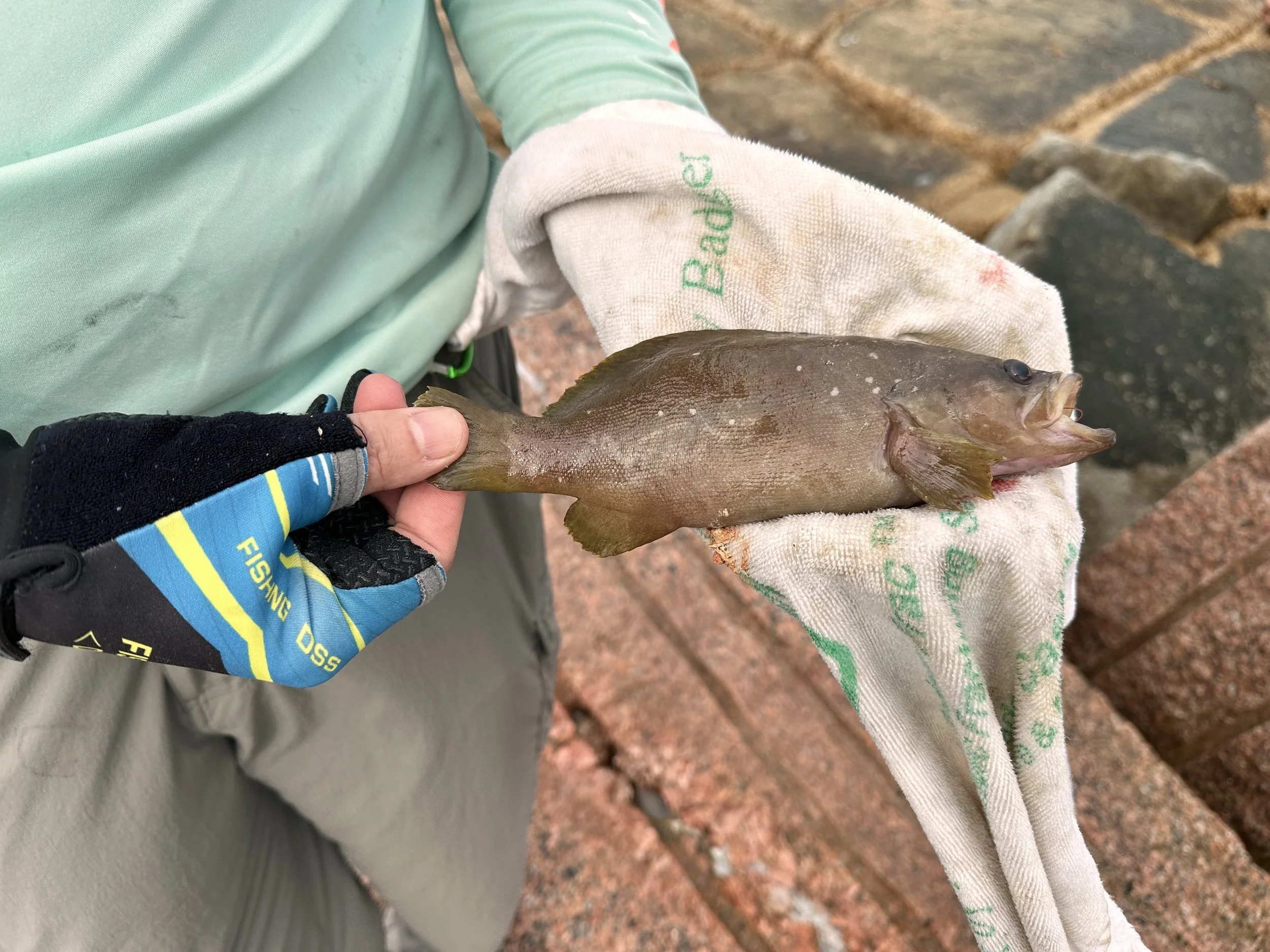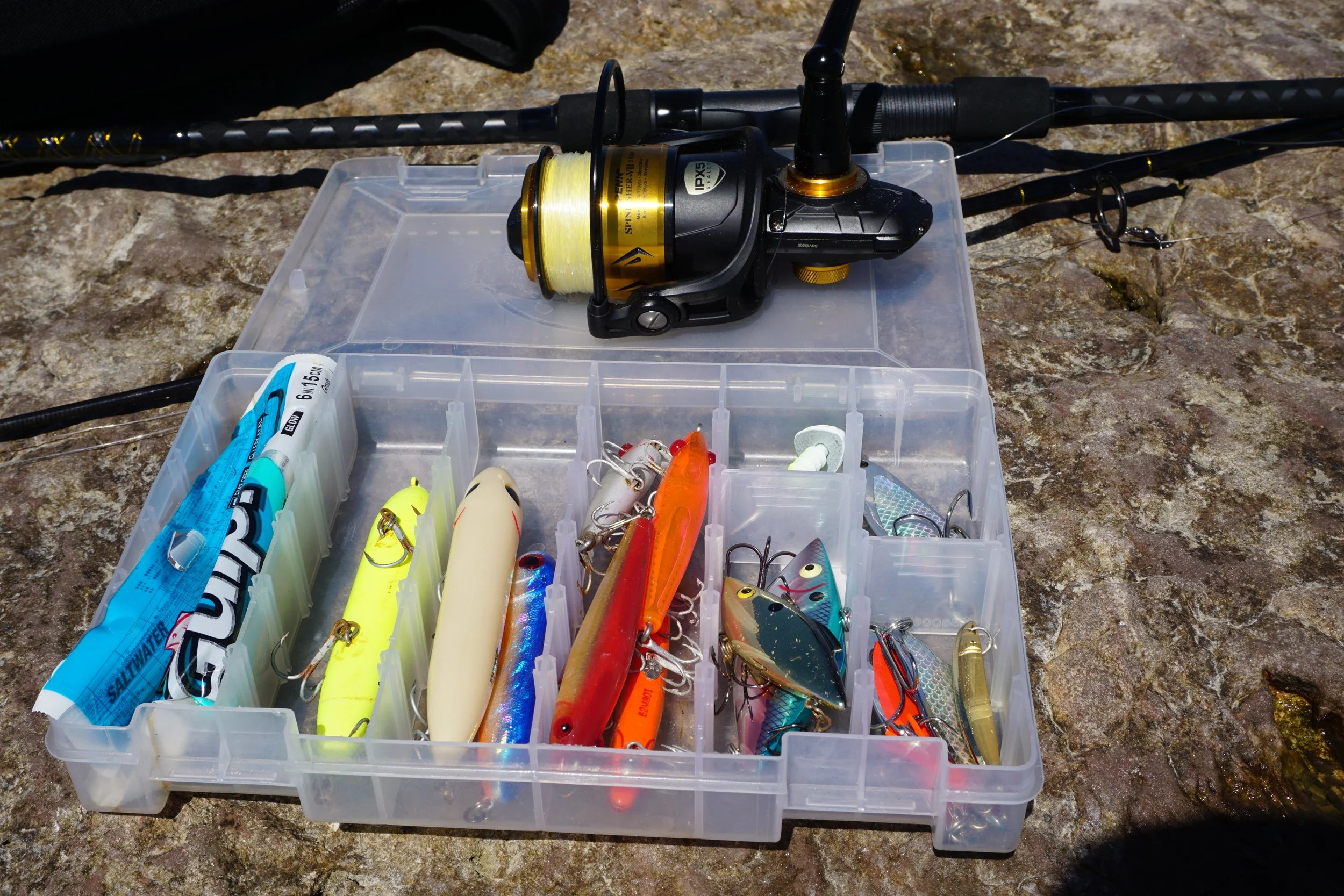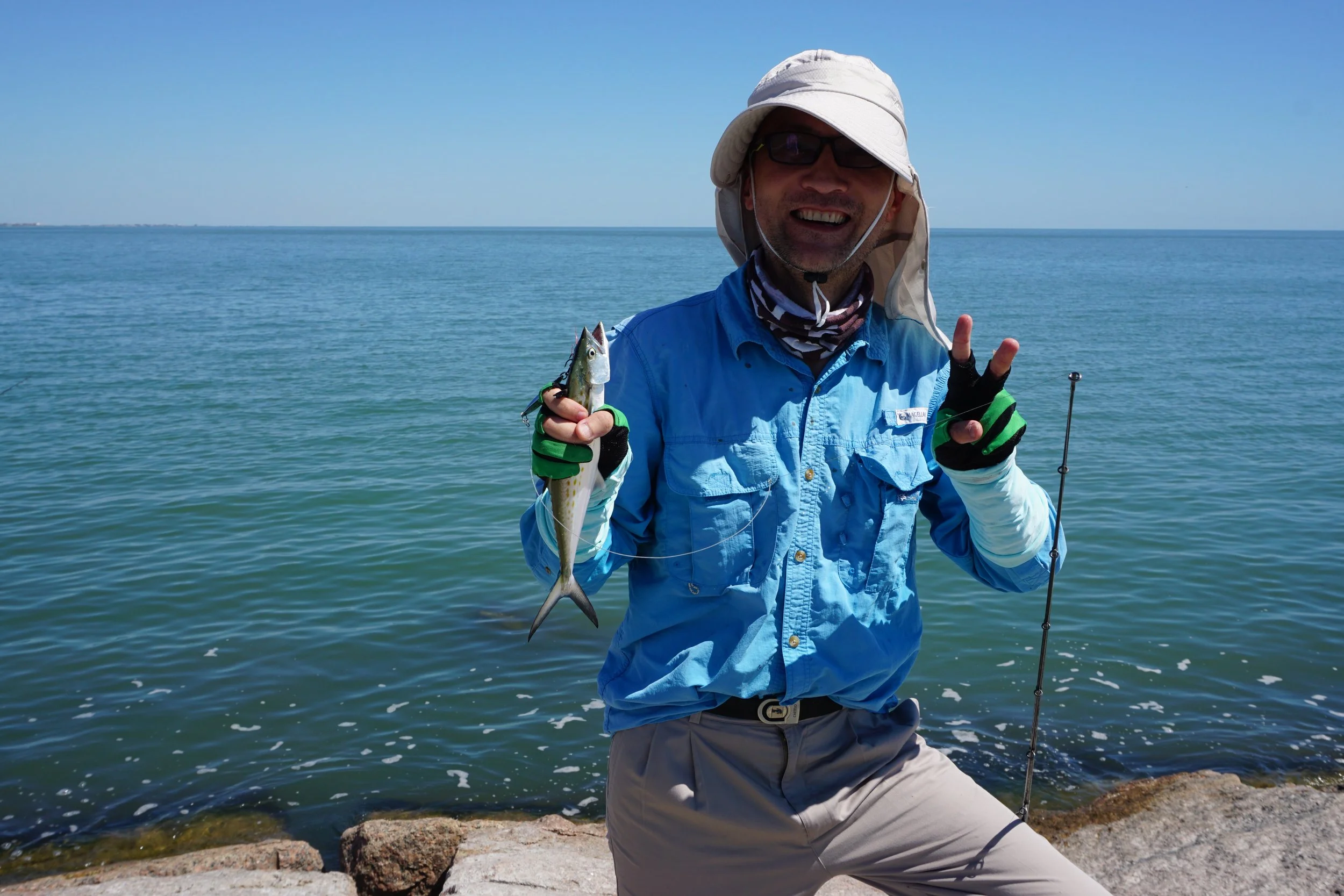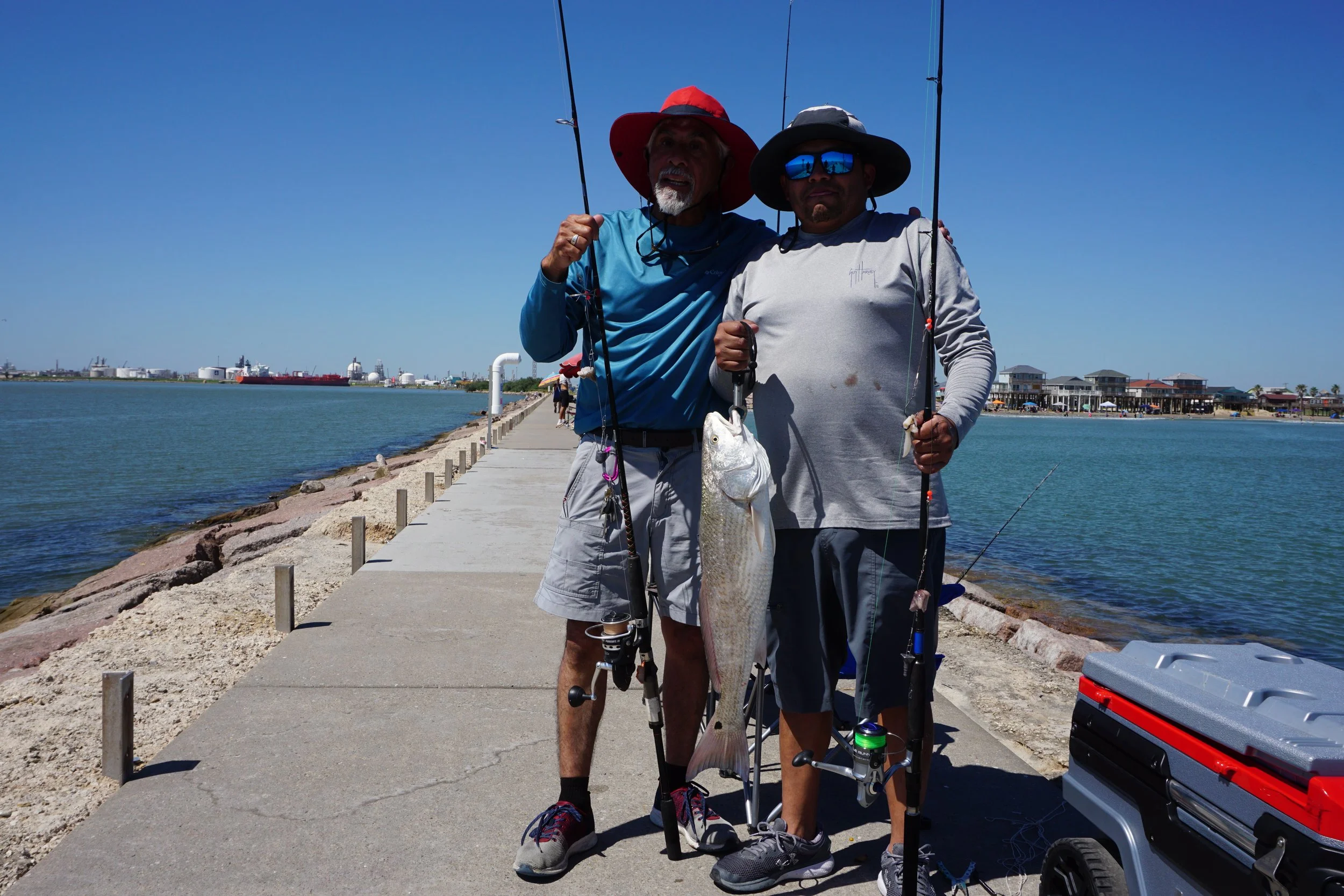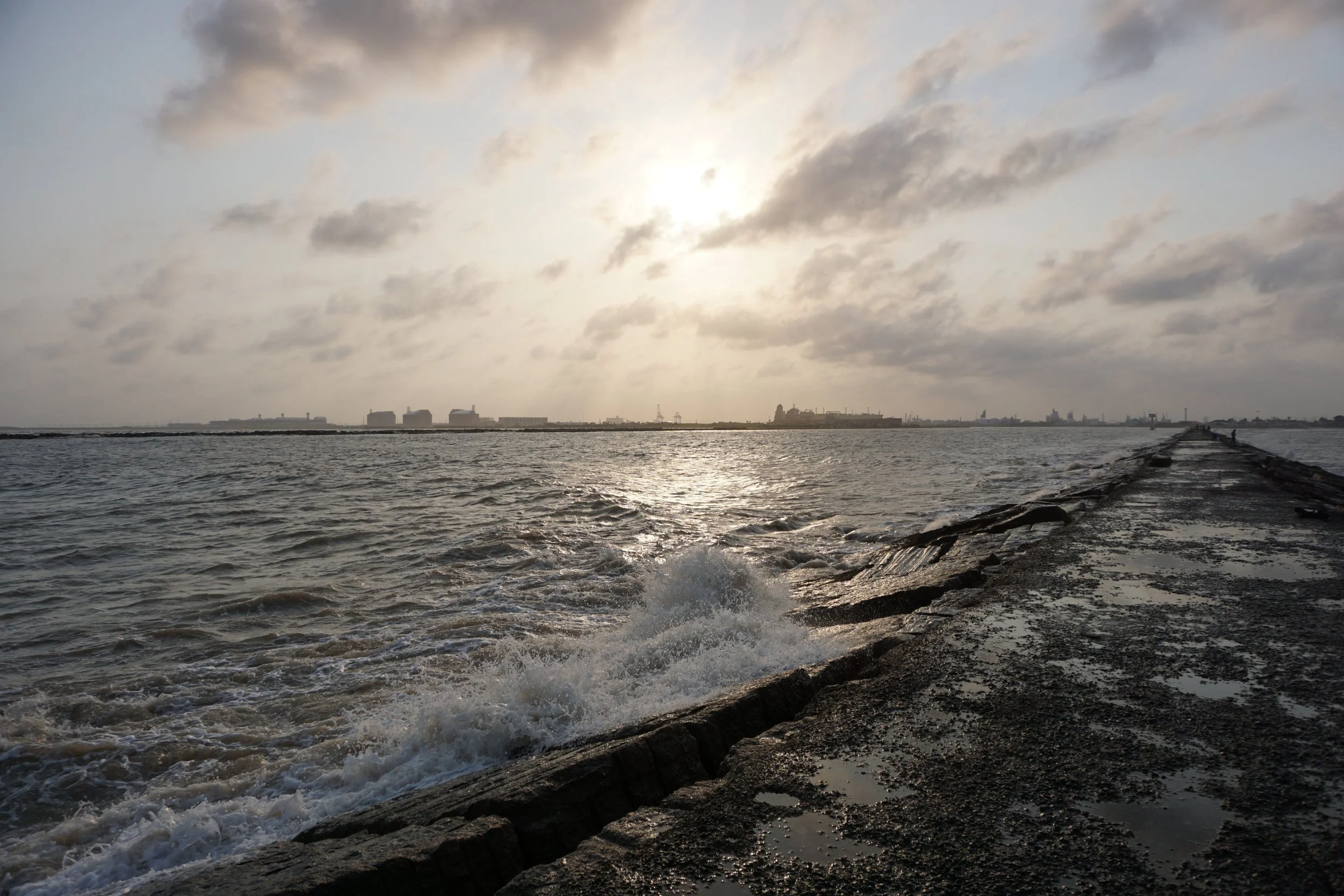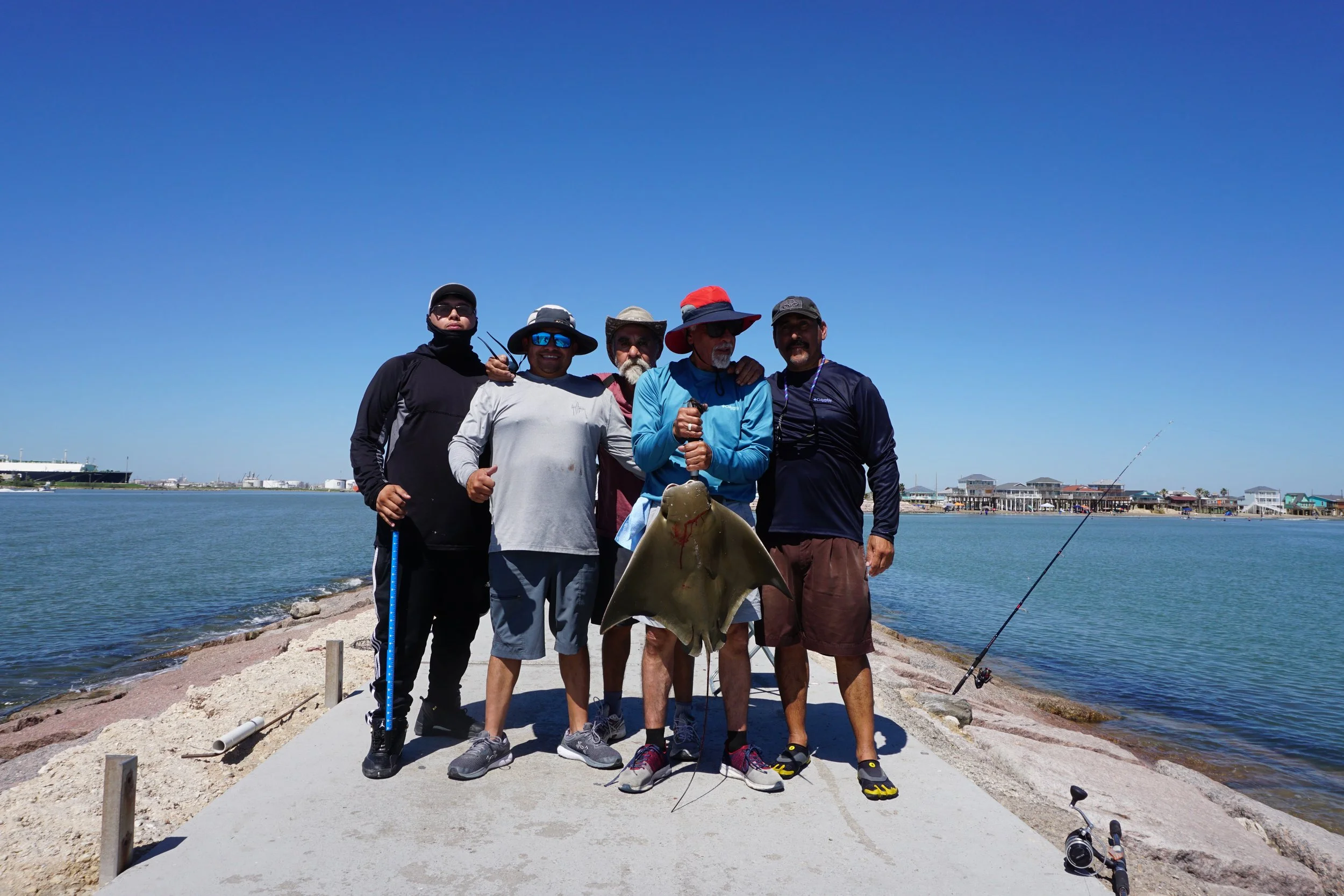Texas Jetty Fishing
Casting off the Galveston Jetty.
Introduction to Jetty Fishing
Some of the most productive fishing in Texas can be at the jetties. Texas has 5 popular jetty locations from Sabine to San Padre. These man-made structures provide habitat to a diverse ecosystem.
You can catch everything from inshore species like reds and specs to pelagic like Spanish and King mackerel. It is no wonder they are popular spots for locals and tourists to wet a line.
Jetty fishing requires a combination of skill, patience, and knowledge to be successful. I will go over the species commonly found at the jetties, tactics, gear, and bait. Each location has some unique fishing opportunities. Each fishes a little differently.
Popular Jetty Fishing Locations
A jetty’s true purpose is to protect navigable waterways from storms, current, waves, and sediment deposits from those events. They have the added benefit of creating habitat for inshore and offshore species. In Texas, there are 4 popular jetties. Their location along the coast of Texas determines what species are most likely to hang around them.
The Sabine Jetty, for example, is more likely than the others to have fresher water, and anglers can expect to find fresh and saltwater species depending on the conditions. Located on the Texas-Louisiana border, you can expect to find trout, redfish, and flounder. If the conditions are right for it, you may even run into largemouth and blue catfish.
The Galveston Jetty is largely affected by the Galveston Bay system. Because of their location and the Bay’s effect on them, anglers are more likely to encounter inshore species like redfish, trout, and black drum. If the water conditions are right, then you can also target pelagic like Spanish and Jacks. Kingfish are less common but not entirely unheard of at this jetty.
Port Aransas is the first jetty on the list that has consistently good water clarity. Unlike Sabine and Galveston Jetties, the Port Aransas Jetty isn’t affected as much by the sediment being flushed out of the bay and river systems. During the month of May, there is a prolific sheepshead run that anglers line the jetty during. And in late summer, there is an even greater chance that anglers can catch King Mackerel.
A lady fish caught on the Port Aransas Jetty. They make great cut bait for big reds!
South Padre Island is the only jetty I have not been to personally. This jetty is known for Tarpon, Shark, and Spanish Mackerel. Anglers have the best chance of being able to catch King Mackerel from shore here. And of course, it holds all of the fan favorites.
Choosing the Right Bait
Your choice of bait will depend on what you are targeting and the conditions of the jetty you are at. You might be thinking, why do conditions matter? Everything eats shrimp. You’re right. How you fish your bait is what matters most; fish are opportunistic. In my opinion, presentation is what matters. Presentation and the right terminal gear. Let me explain:
The most popular bait, bar none and the one you will have the most success using, is, you guessed it, shrimp. There are a couple of ways to fish shrimp, and using the different method will in some cases determine what you catch.
On the right day, free-lining shrimp along the rocks, and you will limit out on sheepshead in no time. Free-lining shrimp is when you bait your hook with shrimp and no additional weight. It allows the shrimp to act more naturally in the water, and it is incredibly effective. It’s also effective for mangrove snapper, which also inhabit the rocks around a jetty.
March through May the sheep head will run. Anglers can catch them close to the rocks on the jetties statewide. This one was caught while free-lining shrimp.
Other effective popular live baits are mullet, croaker, and whiting. I fish them two different ways depending on what I am targeting. If I am looking for cruising trout and Spanish Mackerel, I like to hook them through the tail and pop them back into the jetty.
The second method I like to use is a modified slip rig. The rig is typically tied in a way that the weight is about 12-18” away from the hook with a swivel. I remove the swivel and replace it with a bead. The bead protects the knot on the hook, but it allows the weight to come all the way down to the hook. This prevents me from hanging up on the rocks as much when I retrieve my line. Since the bait is live, I leave enough slack to allow the bait free movement.
When the jetty is not crowded, I prefer artificial baits. You would think because I like to fish that I am patient, but I am not. When I can, I like to move up and down the jetty, casting to nervous water. My favorite is a 1-2oz spoon in silver or gold. Second to that is a 6-inch popper in bone color or a spook. Jigs with soft plastics are also effective baits if the water clarity is good.
Penn Surf Combos are great deals and get you on the water quickly.
Species of Fish Found at the Jetties
Anglers have opportunities to run into a host of different species at the jetties, including pelagic species like king mackerels, Spanish mackerel, triple tail, Atlantic spadefish, and jack crevalle. They take some extraordinary conditions for anglers on the jetty to be able to target and catch. The rest can be caught nearly year-round.
Redfish can be caught all year round at the jetties. Spawning redfish will leave the bay and go out to the Gulf of America late summer, August through October. During this time, they are found at the jetties in good numbers. I recommend releasing any that are caught above the Texas slot. They are the breeders, also known as bull reds.
Trout are another popular species. The jetties provide a great habitat for the more popular speckled trout and its smaller cousin, the sand trout. Both have the iconic 2 front teeth and yellowish mouth. Trout spawn during the summer near shore and in estuaries and inlets. Jetties are a perfect spot for this activity.
Oversized Trout caught on the Galveston Jetty with a Spoon.
Black drum or ‘big uglies’ are caught all year round on the jetties. The spawning run for black drum happens in late winter through early spring. An angler can get caught into some monster big uglies from February through March as they do their thing.
Other species found on the jetties include sheepshead, flounder, mangrove snapper, and Warsaw grouper. The Texas Sea Center in Lake Jackson Tx. Has an excellent exhibit that you can visit for free.
Juvenile warsaw grouper can sometimes be caught on the Jetties as well.
Jetty Fishing Strategies and Gear
As man-made structures, jetties provide anglers with many zones to fish in. Each zone should be approached a little differently. I am going to break down those zones and provide gear and strategy recommendations. If you have any suggestions, I will leave the comments section open so you can add them.
Zone 1: Zone 1 of the jetty is ~10’ from the jetty on both the channel side and ocean side. Here the water is relatively shallow because the jetty formation is just starting its slope. One of the most effective ways to fish this zone is by free-lining shrimp or cut bait. You will typically find mangrove snapper, sheepshead, small Warsaw grouper, and bait fish. A ML light fast-action rod like St. Croix Premier 7’6” paired with a Quantum Smoke size 30 is excellent for this zone and zone 2.
No live bait no problem. All you need can fit in a small Plano box like this one.
Zone 2: Zone 2 of the jetty is beyond 10’ to about 20’ away on both sides of the jetty. Here the water is deeper. In the overall water column from seabed to surface, it’s about mid-level. Here you will find trout, Spanish mackerel, and other cruising predators like jack crevelle using the jetty to trap bait. I do not recommend bottom fishing here. The jetty structure still has not hit the seabed, and you will hang up. Here I like to use 1-3oz spoons, spooks, and suspended jerk baits. If you’re using live bait, use a cork to keep it suspended in the right zone. Depending on what you’re targeting, you may want to use a heavier rod setup like Penn Spinfisher VII.
Zone 3: Zone 3 is anything beyond ~20’. I define it as where the bass of the jetty ends and the beach side or channel side bottom begins. There are fewer rocks to snag on, and bottom fishing is possible. I see some people using spider weight rigs. I do not recommend using those weights. In my experience, when retrieving, you will lose it to the rocks. I prefer a slip weight rig I mentioned earlier. If you are targeting this zone for kings and jacks, you want bigger reels and heavier rods. When fishing this area, fishing drones can be used to launch bait even further out from the shore.
Here are a couple of big takeaways:
You do not have to cast a country mile to be successful. In fact, most of the fish I have seen caught at the jetties are within zone 1 and the border of zone 2.
Adjust your tackle and tactics to your targeted species. You can catch anything on shrimp. If you are targeting jacks, you will probably have better luck with a fast-moving bait.
Both channel side and ocean side are productive in these zones. You will find more bay species on the channel side. So, if you’re looking for big reds, target the channel side.
In the heat of summer jetty anglers can effectively target spanish mackerel.
Couple of lucky anglers with a big bull red on the Galveston Jetty.
Safety Precautions
Jetty fishing can be hazardous. There are some safety precautions anglers should use. When conditions are bad and the jetties are wet, the rocks can be extremely slippery. Wearing a good pair of shoes is helpful.
For extra security, investing in cleats like Korkers Neo Flex can really make a difference. Make sure to check that your state doesn’t have any regulations against cleats before you go.
Landing fish is a challenge in itself on the jetties. Because of the construction of the jetty, there is usually a pretty significant sloped distance between the walkway and the water.
A safer way to land fish is either with a long-handled gaff or net. Be sure to know your state regulations before gaffing a fish.
Avoid going out on a jetty when the waves are crashing over it. Uncontrolled falls can land you in the crevices of the jetty formation. If you’re lucky, you sprain your ankle; if not, a broken bone is worse. You should always fish with a friend.
Wet conditions on a jetty can lead to slips and trips. Be cautious when you go out.
Tips for a Successful Trip
Fishermen are required to use a variety of strategies while fishing jetties. To be constantly successful, you will need to adjust to changing conditions in tide, wind, and temperature. Here are 5 tips to increase your success when fishing the Jetty.
Plan your trip. Take into account tide, weather, and temperature. I prefer an outgoing tide. I seem to have the most success when the water is moving. One thing I started doing was putting my fishing days into my calendar. On days I catch fish, I log the weather in a fishing log. I can then use the information to replicate success on another day.
Don’t be afraid to move. When I can, I like to plan my trips on weekdays and in the early morning. I am more likely to be able to have the pick of jetty spots. This way, I can see where the bait is moving or where eddies might be forming and trapping baitfish.
Know the fish. You can catch fish all year round on the jetties. If you want to be consistently successful you need to know your target. I mentioned above a few key things you should know about the species commonly targeted. Knowing when the fish will most likely be there is part of the battle.
Stick close to structure. If you know that there is structure out away from the jetty, have at it. However, just know that the jetty itself holds fish, and it gets deep quickly. You do not have to cast far from it to catch fish. Many of the interviews I have done of anglers on jetties say they catch their fish less than 15’ away from the jetty.
Match the hatch. You hear fly fishermen say this all the time. It holds true for conventional tackle guys as well. Match the bait you’re seeing along the jetties. It does change depending on the time of the year.
Conclusion
Jetty Fishing is a popular and exciting activity along the Texas Coast. It offers a wide range of species for shore-side and boat anglers alike to pursue. The jetties provide a combination of unique challenges fishermen of all levels can enjoy. With a little planning, the right bait, and some patience, you can be successful at your nearby jetty.
